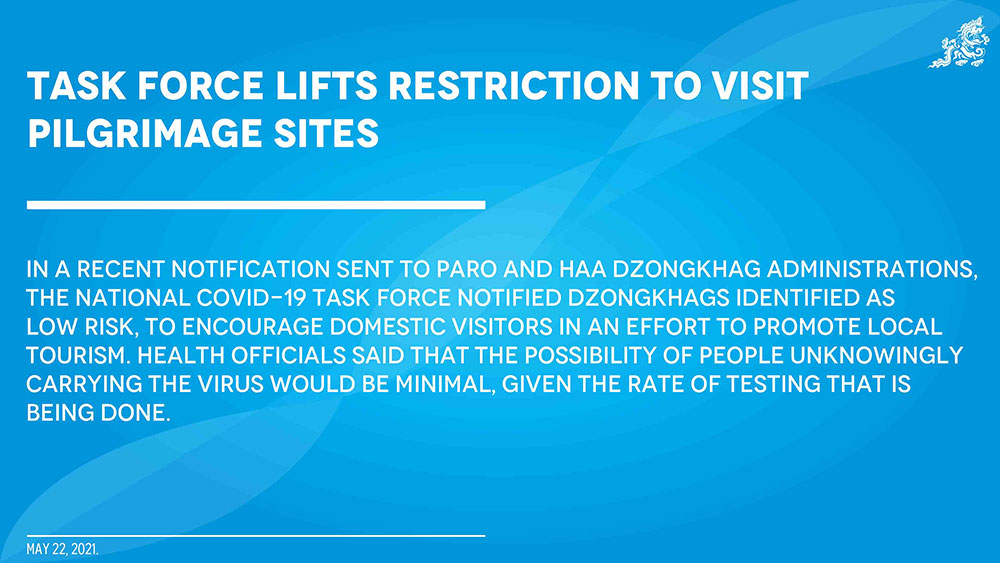The national Covid-19 task force notified that dzongkhags identified as low risk should encourage domestic visitors, as it benefits the local economy.
In a recent notification the task force sent to the Paro and Haa dzongkhag administrations, it was stated that increasing domestic pilgrimage or travel in the low-risk areas was beneficial for the local economy, employment generation and redistribution of income.
It recommended that dzongkhags should encourage such travel and visits.
Paro and Haa dzongkhags had recently suspended domestic tourists from visiting their dzongkhags in the light of growing Covid-19 cases in the country.
On May 4 this year, Haa dzongkhag administration suspended all visits to Nub Tshonapata until further notice to avoid the risk of disease transmission in the dzongkhag.
Paro dzongkhag administration also issued a notification recently restricting people from other dzongkhags to visit religious (nye) sites in Paro.
The national task force stated that the dzongkhags, in coordination with the tourism council, should submit proposals on waste management and developing local tourism to the national task force.
“Till such time, the dzongkhags should avoid taking unilateral decisions relating to travels and visits by people from other dzongkhags,” the notification stated.
Haa dzongkhag’s Gakiling gup, Gashey, said that before the restriction from the dzongkhag many people visited the Rangtse Nye located in gewog in groups.
He said that after the restriction, the numbers drastically dropped.
He said that the task force’s decision to allow domestic visitors was timely, as it helped some of the gewog residents who organised trips to the nye. “For the gewog, there is no direct income generation from such visits but it helps our people to earn some income.”
The gup said that the gewog’s women association would soon be constructing grocery stores from where visitors could shop during the trip. “This association is also tasked with waste management in the area.”
Another popular pilgrimage destination is Dragay Pangtsho in Tsento gewog, Paro.
Tsento Gup Dolay Tshering said that before the pandemic, it was mostly locals who visited the lake. “Foreign tourists mostly visit Jomolhari which also goes through our gewog. This used to contribute to our people providing pony services.”
He said visitors to both places have now reduced due to the pandemic. “The few that visit Dragay Pangtsho return on the same day, thereby not making any significant contribution to the local economy.”
Instead, he said that many residents had raised concerns over visitors polluting the sanctity of the nyes and the residents facing the wrath of the local deities.
Some residents also questioned if it was wise to allow visitors when an increasing number of Covid-19 cases were being detected from the communities.
A Paro resident said that there was a high possibility of people carrying the virus silently while visiting, as many don’t show any symptoms in the beginning.
She said that although the government has been conducting several tests, a slight overlook could cost the entire community and the country.
However, health officials said that given the current scenario, the possibility of people unknowingly carrying the virus would be minimal given the rate of testing that is being done. “All high-risk groups are regularly tested and we have a good surveillance system in place to monitor the situation.”
By Younten Tshedup


